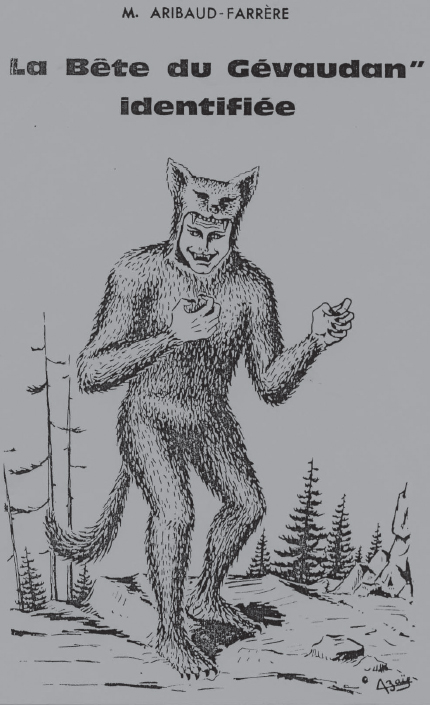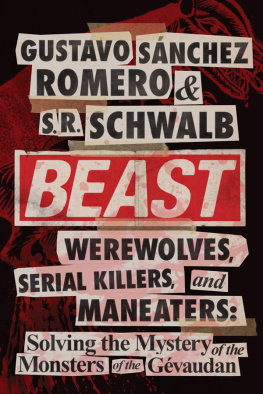Copyright 2016 by Gustavo Snchez Romero and S. R. Schwalb
France and the Gvaudan Region map cartography copyright David Lindroth Inc.
All rights reserved. No part of this book may be reproduced in any manner without the express written consent of the publisher, except in the case of brief excerpts in critical reviews or articles. All inquiries should be addressed to Skyhorse Publishing, 307 West 36th Street, 11th Floor, New York, NY 10018.
Skyhorse Publishing books may be purchased in bulk at special discounts for sales promotion, corporate gifts, fund-raising, or educational purposes. Special editions can also be created to specifications. For details, contact the Special Sales Department, Skyhorse Publishing, 307 West 36th Street, 11th Floor, New York, NY 10018 or .
Skyhorse and Skyhorse Publishing are registered trademarks of Skyhorse Publishing, Inc. , a Delaware corporation.
Visit our website at www.skyhorsepublishing.com.
10 9 8 7 6 5 4 3 2 1
Library of Congress Cataloging-in-Publication Data is available on file.
Print ISBN: 978-1-63220-462-2
Ebook ISBN: 978-1-63220-780-7
Cover design by Rain Saukas
Printed in the United States of America
Readers interested in the cryptozoological artwork of Gustavo Snchez Romero may contact him at
Table of Contents
To the Reader
T his book is inspired by true events that occurred in France from June 1764 to June 1767. The subject of this book is known as the Beast of the Gvaudan, but the Beast was actually two or more creatures that ranged south-central France in the Gvaudan and in neighboring Auvergne and the Vivarais. Something to keep in mind: La Bte (the Beast) is a feminine noun in French. Thus, in accounts quoted herein, such as that of the 1889 chronicle by the Abb Pierre Pourcher, the Beast is referred to as female (she attacked, she devoured, and so on). For simplicitys sake, we refer to the creature or creatures described herein as the Beast. Please note: To simplify comparisons of the animals discussed in this book, not all illustrations are to scale.
We are fortunate in this journey to have the company of respected Beast researcher, documentarian, and author Phil Barnson, from Bziers in the south of France. Phil maintains the website www.labetedugevaudan.com.

La Bte du Gvaudan identifie, by Mademoiselle Marguerite Aribaud-Farrre. Phil Barnson .
Foreword
O nce upon a time long ago in rural France, in a land known as the Gvaudan, a young shepherdess was found dead, slaughtered by a mysterious bte froce , a ferocious beast. This bloodthirsty monster then attacked and killed otherschildren, women, and menbringing about a never-ending night of dread that lasted three long years.
The peasants who eked out hardscrabble livings during this reign of terror came to wonder every single day: Would they know the next victim? Would they be the next victim?
***
I have been caught up in the clutches of the Beast since I was a boy growing up in the Languedoc region of France. Here, in the country of the Beast, the story has been passed from generation to generation since the occurrence of these horrifying events more than two hundred and fifty years ago.
My father possessed a booklet about the creature, called La Bte du Gvaudan identifie , by Mademoiselle Marguerite Aribaud-Farrre. It was stapled, with a stark orange-yellow cover, upon which was a black-inked illustration of a man dressed from head to toe in wolfskin, his face leering out of the open jaws of the dead wolf.
I still have this booklet, and, as I look at it now, I recall poring over this picture many years ago, carefully studying the wolfman who menaced readers with his claw-like fingernails and vampire-like teeth, ready to leap out of a foreboding forest. My hair would stand on end as I eyed the monster, recalling the stories of the Beasts ravages. It served as inspiration when I played in our familys attic, imagining hunting the werewolf myself, accompanied by my worthy companions, action figures G. I. Joe and Big Jim. Id pretend wed gone back in time to Old France to find the Beast, and Id peer into the darkest corners, searching for our prey. But if there was a sudden sound, such as a creak of the house settling or a branch scraping a window, Id freeze, eyes wide, heart pounding, clutching the grip of an antique saber I kept hidden under the eaves.
***
Years later, still on the Beasts trail, I decided to create a website that I call In the Shadow of the Beast , www.labetedugevaudan.com, that would make the facts about the monster and its world available to all who were interested. And when I began sifting through the stories, I was surprised to find that most were never verified.
So I decided to confirm as much as I could, with the help of as many professionals as I was able to contact. And I made the information available to all, with no need to register. Readers could also use the content freely; all I asked was that they just mention where it came from.
***
People are often surprised to learn this is a true story. In France, so many things have been said and written about the Beast over the years that many believe this simply is a story. And those who are interested in the real account get lost in snarls of fact and fiction. They ask: When did this happen? How poor were the people? There was a king at that time, right? What, you say there were no roads?
I like to think they can find all they need to situate the case well enough in history, and, more importantly, in reality, on my site. I try to be as objective as possible so those who visit can find rational facts and almost scientific explanations for something that has become legend. Who wouldnt want to investigate a legend such as this?
Today, though I believe www.labetedugevaudan.com is the most complete site on the Web, it remains far from exhaustive.
For it does not solve the mystery.
***
What was the Beast of the Gvaudan?
Where did it come from?
You see, some say it was a wolf.
Some say it was a hyena or a lion, escaped from a menagerie.
Some say it was a man in wolfskin.
Some have said it was a scourge sent from God.
The only thing I am certain of is that no one will ever really know the answer, unless they could truly go back in time.
But perhaps, in the long run, it does not matter. What might matter more is the story told by the information contained within French archives and parish records. There is extensive documentation of the Beast, and it has been studied by specialists from the nineteenth century through today.
What the archives reveal is a story far bigger than one about a strange animal that killed children and women.
From the remote French countryside to the royal court in Versailles, its about an entire microcosm with many components nested within each other, into which a number of complex agents were tossed: Social problems resulting from poverty in a land where justice was dispensed by religion, livestock succumbing to outbreaks of disease, a little ice age that made winter last from October to June, and a challenging landscape with no real roads of any kind.
There you have a thumbnail of life in the Gvaudan at that time.
Think things couldnt get any worse? Thats what the peasants thought, too!
***
I admit I have favorite theories myself. But I have no answer. I only tell people what I know, what Ive learned along the way, and then I propose solutions that are always open to any correction.











![Charlotte Greig - Evil Serial Killers. In the Minds of Monsters [Fully Illustrated]](/uploads/posts/book/70143/thumbs/charlotte-greig-evil-serial-killers-in-the-minds.jpg)



